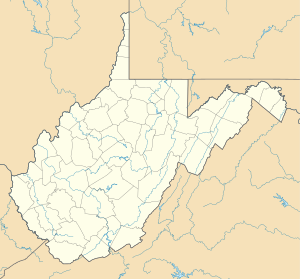Battle of Charlestown
| Battle of Charlestown | |||||||
|---|---|---|---|---|---|---|---|
| Part of the American Civil War | |||||||
|
|||||||
| Belligerents | |||||||
|
|
|
||||||
| Commanders and leaders | |||||||
| Benjamin L. Simpson | John D. Imboden | ||||||
| Strength | |||||||
| 1,125 | 1,900 | ||||||
| Casualties and losses | |||||||
| 452 (22 killed, 50 wounded, 382 captured) | 61 (40 killed and wounded, 21 captured) | ||||||
|
|
|||||||
The Battle of Charlestown was a small engagement between Confederate cavalry forces under Brig. Gen. John D. Imboden and the Union forces under Col. Benjamin L. Simpson on October 18, 1863, at Charlestown, West Virginia, as part of the Bristoe and Mine Run Campaigns, resulting in a Confederate victory.
As the Confederate Army of Northern Virginia and the Union Army of the Potomac dueled it out in central Virginia during the Bristoe campaign, General Robert E. Lee dispatched cavalry under Brig. Gen. John Imboden to raid in the Shenandoah Valley and attack the vulnerable Union garrison at Charlestown, West Virginia, in an effort to draw Union forces away from his front. By October 17, Imboden's force had reached Berryville, where they skirmished with a company of the 1st New York Cavalry before driving them back to Charlestown. The presence of the Confederates was reported to Benjamin Simpson, commander of the Charlestown garrison. The inexperienced Simpson, having been mustered into service only 17 days earlier, dismissed recommendations to fall back on the much more strongly defended Harpers Ferry, believing Charlestown was not the target of the Confederate raid.
At dawn on the 18th, Union pickets south of Charlestown were driven back by Imboden's advance. Simpson's 9th Maryland Infantry, numbering some 375 men, took up position in the Jefferson County Courthouse (in which John Brown was tried and hanged) and ordered the cavalry, consisting of one company each of the Loudoun Rangers and 6th Michigan Cavalry, to "take care of themselves". Upon entering town, Imboden sent a flag of truce to negotiate surrender, to which Simpson refused. The cavalry, seeing the hopelessness of the situation, decided to fight their way out and unite with the Harpers Ferry garrison. On the northeast outskirts of town, the Union cavalry encountered the 18th Virginia Cavalry and 62nd Virginia Mounted Infantry, who unleashed a volley at the column, sending several troopers and their horses to the ground. Those troopers who were still mounted broke left around their felled comrades and serendipitously rode into the Confederate right, which was proved to be its weak spot. The Union cavalry cut its way out, taking heavy losses: 17 captured, 2 killed and several wounded and nearly every horse shot, several killed.
...
Wikipedia

